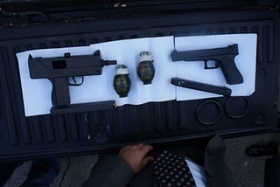The trafficking of weapons over the U.S.-Mexico border is well-documented — lesser known but also significant is the sale of U.S. weapons to Guatemalan government contractors, which are then siphoned off to criminal groups.
The Mexican government has focused much of its efforts to stop arms trafficking on the smuggling of weapons over the U.S. border. This strategy ignores other sources of weapons, and other entry points. Central America, for example, represents a major source of weapons. U.S. authorities have said that the vast majority of high-caliber, non-conventional weapons seized in Mexico come not from the U.S., but from Central American military arsenals.
Guatemala is a major source country for Mexico’s guns, with both weapons left over from the Cold War and ones trafficked into the country from the U.S. Many of these weapons are imported to Guatemala by government contractors, who then sell them on to private security firms. The three-stage process was described by Rafael Antonio, a retired Guatemalan military officer, in an interview with Noticias Televisa.
Import: Many trafficked weapons are imported from the U.S. via government contractors. These contractors import small quantities of weapons from U.S. warehouses, and then sell them on to the government and to private security firms. Buying prices range from $700 to $1,000, and selling prices from $2,200 and $2,500. There is no control on the amount of weapons that contractors import, so, for example, if the government makes an order of 5,000 weapons, the company can legally purchase a greater amount, say 10,000, and do what they please with the surplus.
Diverting weapons to the black market: Once inside the country, weapons are lightly regulated, meaning they can be sold without leaving a paper trail. Due to corruption of some public officials, many weapons are not registered to the General Directive for the Control of Weapons and Munitions (DIGECAM), according to the testimony. A middleman facilitates these business transactions through a number of front companies for armored clothing and lease/purchase of armored vehicles, and handles the paperwork for imports. Besides the lack of a legal framework for the import of weapons, the middleman also bribes state officials to turn a blind eye to transactions with third parties, sometimes criminal groups.
Cross-border smuggling: Finally, the weapons are taken into Mexico; either smuggled through border crossings by the vendors, or by the buyers after being handed over close to the border. Sometimes they are transported by sea or through unofficial entry points along the border.
This process is just one of the several methods used to traffic weapons in Guatemala. As with other countries in the region, institutional weakness is widespread and corruption is rampant, so it is not uncommon for criminal groups to obtain firearms from weapons caches with help from corrupt military officers.
Border control
Despite the amount of arms smuggled over Mexico’s southern border, most of the investment in border control to counter organized crime has gone to the U.S. border, with an investment of about $287.5 million in 2009 as part of U.S.’s Merida Initative, while the southern border received only $3 million of U.S. aid that year.
A recent study by the CESOP (Centro de Estudios Sociales y de Opinion Publica), a government commission tasked with diagnosing the state of the customs service in Mexico, found that customs operations are porous, run as a closed system and managed by various individual interests, and lack a proper institutional design.
The report states that illicit smuggling is prevalent because of incompetence, corruption, and lack of technological infrastructure. It goes on to say that in 2006 and 2007 only 2 percent of illegal weapons (900) were confiscated at customs, while the rest (38,404) were confiscated inside the country in raids by the military.
Corruption was singled out as the main problem affecting border management and the customs service. The commission claimed there had been a significant rise in the perception of corruption in the customs service, mentioning bribes and threats against customs agents by drug trafficking organizations as the most prevalent issues.
Mexico could invest more in border control, but only by reforming its mafia-like customs service will it see any tangible results. This could eventually lead to a more competent border management that can reduce illicit trafficking on the south border, as well as the north.

